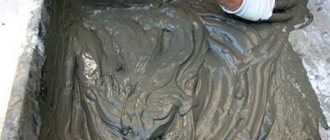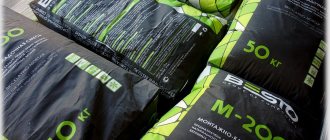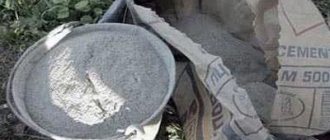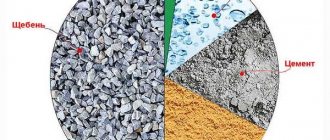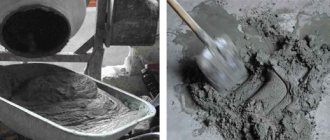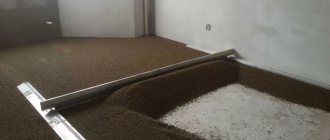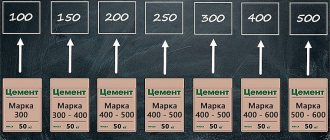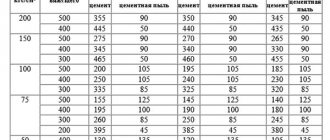Looking at bags of cement and a pile of sand, not every developer feels calm and confident. He is tormented by the question: what proportion should be chosen for the solution so that it turns out strong enough and does not “eat up” extra money?
Sprinkling “by eye” is stupid and dangerous, especially when it comes to critical concrete work on the foundation or brickwork. Following the principle “the more the merrier” is also not an option. When it comes to cubes, such a rule can ruin the developer.
Another question that arises in this regard: how to control the work of the builders who are tasked with preparing the mortar and concrete? You can’t keep track of everything, so there is no guarantee that the cement will not go “to the left”, and the foundation and masonry will not soon collapse.
If the customer knows exactly what the standard consumption of cement and sand is for the mortar, it is easier for him to control his costs and monitor the use of purchased materials.
“Old-father method” or current SNiP?
Experience is a good thing, but we should not forget about building regulations. They take into account all the factors associated with the preparation of mortars and concrete (purity, coarseness, moisture content of sand and crushed stone, cement activity and water quality).
Therefore, when preparing for work on pouring a foundation, screed or laying walls, do not be lazy to look at the GOST tables. You only need one or two lines in them. They clearly describe what the cement consumption per cube of mortar should be to obtain the required strength (grade).
Here is a simple “squeeze” from SNiP, which will help prepare a high-quality mortar for masonry and screed . After studying it, remember that the given consumption rates differ slightly from practical values.
| Cement brand | Brand of solution | Cement consumption rate for making 1 m3 of mortar |
| M400 | M200 | 490 kg |
| M500 | M200 | 410 kg |
| M400 | M150 | 400 kg |
| M500 | M150 | 330 kg |
The reason is that they are produced from standard preparation conditions (air temperature +23C, medium-grained sand, ideally clean, its humidity no more than 7%, etc.). It is not realistic to ensure standard parameters for mixing at a construction site, so it is better to purchase cement with a small reserve (10-15%).
The answer to the question of how much cement and sand you need per cube of concrete will be given by the following standards:
| Concrete grade | Cement consumption M500 kg/1m3 |
| M100 | 170 |
| M150 | 200 |
| M200 | 240 |
| M250 | 300 |
| M300 | 350 |
| M400 | 400 |
| M500 | 450 |
When making concrete, it is important to know not only the amount of cement, but also the standard volume of sand and crushed stone. The following table will be useful for calculations.
Volumetric proportions for various grades of concrete
| Concrete, brand | Ratio of cement/sand/crushed stone in liters | |
| cement M 400 | cement M 500 | |
| 100 | 1,0 : 4,1 : 6,1 | 1,0 : 5,3 : 7,1 |
| 150 | 1,0 : 3,2 : 5,0 | 1,0 : 4,0 : 5,8 |
| 200 | 1,0 : 2,5 : 4,2 | 1,0 : 3,2 : 4,9 |
| 250 | 1,0 : 1,9 : 3,4 | 1,0 : 2,4 : 3,9 |
| 300 | 1,0 :1,7 : 3,2 | 1,0 : 2,2 : 3,7 |
| 400 | 1,0 : 1,1 : 2,4 | 1,0 : 1,4 : 2,8 |
| 450 | 1,0 : 1,0 : 2,2 | 1,0 : 1,2 : 2,5 |
The required sand consumption per 1 m3 of solution is 1 cubic meter . Some developers are mistaken in believing that the volume of cement increases the volume of the finished mixture. This is wrong. The cement is very finely ground, so it is distributed in the voids between the sand, without increasing the total volume of concrete and mortar. Therefore, for 1 m3 of sand we can add 200 and 400 kg of cement, obtaining the same 1 cubic meter of solution.
Water is added to the mixture according to a simple proportion - half of the total weight (not volume!) of cement . In this case, you need to take into account the actual moisture content of the sand and pour water in small portions so that the solution or concrete does not turn out to be too liquid.
The consistency of the solution according to the standards is determined by the amount of sediment of a standard metal cone lowered into the mixture. You are unlikely to be able to conduct such a test on a construction site. Therefore, just remember that the thickness of the masonry mortar should be such that it is not too hard, but rather flexible and does not leak out of the seams. For the screed, the mortar and concrete must be of medium thickness so that they can be easily compacted and leveled according to the rule.
What determines cement consumption for different solutions?
The preparation of cement mortar, the proportions of which may differ, requires strict adherence to technology and the correct determination of the ratio of components. To use different grades of concrete, different amounts of cement and sand are used. Remembering the proportions of cement and sand is not enough for high-quality construction; it is better to understand the principle.
Requires strict adherence to the technology for preparing cement mortar
Main factors influencing consumption:
- the amount of fillers in the mixture. The greater the proportion of crushed stone and sand, the higher the cement consumption per 1 m3 of solution. Cement is the binder of the components, which is responsible for holding all the fillers together. The ratio of bulk mixtures determines the amount of cement;
- brand of cement. As the grade increases, the strength of the final structure increases. It is worth remembering that the grade of the final mixture is significantly lower than dry cement, since sand is added to the composition, and gravel or slag can also be added;
- brand of solution. The cement-sand mortar is also divided by grade. For all types of work, GOST has recommended brands. After determining the desired brand of construction mixture, you can choose the right brand of cement. For example, to obtain an M100 mixture from M500 cement, you will need to mix 1 part Portland cement, 5.8 parts sand and 8.1 parts crushed stone. If the final goal is M450 solution, a proportion of M500 cement (C:P:SH) will be required: 1:1.4:2.9;
The density of cement plays a secondary role here, since it directly depends on the brand of cement, but it is necessary to know it during the calculation process.
Conclusion: how much cement is required per 1 m3 of mortar depends on the required strength of the mortar and the brand of the initial mixture.
The density of cement directly depends on the brand of cement
How many bags of cement should I buy?
Before things get to the point of mixing, it is important for the developer to know how many bags of cement will have to be purchased. Here you should also build on standard consumption rates.
Let's say we need to calculate the cement consumption for floor screed . The optimal proportion to ensure high strength is 1:4. For this work we will need ¼ cubic meter of cement. To convert cubes into kilograms, use the average bulk density of the binder: in 1 liter - 1.4 kg of cement.
1/4 of a cube is 250 liters. Multiplying them by 1.4 kg, we get 350 kg of cement. So, in total we will have to purchase 350/50 = 7 bags of cement (50 kg each) or 14 bags of 25 kg each.
You can calculate the binder consumption per 1 m2 of screed using the “reverse” method . With a thickness of 10 cm, filling one “square” will require 0.1 m3 of solution. It contains 10 times less cement than 1 cubic meter: 350 kg/10 = 35 kg. For a screed 5 cm thick we need 35/2 = 17.5 kg of M500 cement.
The rate of cement consumption is greatly influenced by its activity. It is determined experimentally by mixing control samples and testing them for strength. This method is not suitable for the average developer. A rule of thumb to follow when purchasing and before using is shelf life.
The loss of activity by cement can reach 20% in one month. Therefore, after keeping this material in the garage for three months, instead of grade 500 indicated on the label, you will receive grade 400. When using such a binder for mortar or concrete, take the consumption rate specifically for this (lower) grade. If cement waits for its “finest hour” for six months, then it is not suitable for anything other than disposal to a landfill.
Vigilance should also be exercised when purchasing binders, requiring the seller to provide a certificate for the purchased batch, which indicates the factory production date.
Material consumption rates per cubic meter of different solutions
Today there are 4 main areas of use of concrete: foundation, masonry, screed and plaster. In each case, special requirements are imposed on the building mixture, which makes the choice of cement and its consumption different. The greatest consumption of cement per cube of concrete occurs when it is necessary to make masonry or plaster. The consumption of materials per 1 m3 of foundation mortar is slightly lower due to the use of a large filler fraction: slag, crushed stone or gravel.
GOST has records of cement consumption rates per 1m3 of mortar, taking into account the purpose of the mortar. Designation of concrete per cubic meter. meters is a generally accepted system of measurement.
Cement consumption rates per 1 m3 of mortar
Consumption rates per 1 m3 using M500 cement:
- on M100 – 170 kg;
- on M150 – 200 kg;
- on M200 – 240 kg;
- on M250 – 300 kg;
- on M300 – 350 kg;
- on M400 – 400 kg;
- on M500 – 450 kg.
Consumption rates for cement and sand per cube of foundation mortar
Calculating cement for a foundation calculator is the easiest way to understand how much material is required and the number of necessary components. Concrete calculations can be done with high accuracy and manually.
To determine how much cement is needed per 1 m3 of solution, we recommend following simple instructions:
Cement consumption rates for foundations
- We determine the appropriate brand of cement mortar. Usually, when creating a foundation, it is advisable to use a solution of M100-M300. For low-level buildings, M100 is sufficient, if you plan to build several floors - M150, and M200 and higher are used in the construction of multi-story buildings and any structures that have increased strength requirements. If the foundation is being built for a wooden building, M50 mortar is sufficient.
- We select the brand of cement. For standard tasks, M300-M400 is suitable in the proportion of cement to sand 1 to 3. When using cement M500 - 1 to 5.
How many kg of cement in 1 m3 of solution:
- in M50 when using M400 – 380 kg;
- in M100 when preparing concrete from M300 cement – 214 kg;
- in M200 with cement M400 – 286 kg;
- in M300 at M500 – 382 kg.
The data is presented if the cube contains 2-4 parts of sand and 3 parts of crushed stone.
Consumption rates of cement and sand per cube of masonry mortar
To prepare cement mortar for wall construction, a proportion of 1 to 4 is most often used. Thus, the cement consumption per cubic meter will be 0.25 m3 or 325 kg, and the sand consumption per 1 m3 of mortar will be 0.75 m3 or 1200 kg.
Cement consumption rates for masonry
To calculate how much mortar will be needed per 1 m3 of brickwork, it is important to take into account the thickness of the wall.
Table 1: Mortar consumption for walls of different thicknesses
| Thickness in bricks | Consumption, m3 |
| 0,5 | 0,189 |
| 1 | 0,221 |
| 1,5 | 0,234 |
| 2 | 0,24 |
| 2,5 | 0,245 |
To calculate how many bags of cement are needed, just multiply 325 kg by the consumption per cubic meter, for example, walls of one brick - 0.221. You will get 72 kg of cement for laying 1 m3 of wall, provided that the composition does not contain other components (lime, clay, etc.).
Consumption rates of cement and sand per cube of screed mortar
Cement consumption per 1 cubic meter of solution is calculated according to similar rules as in previous mixtures. The recommended mixing ratio is 1 to 3. Difficulties in calculations often appear at the stage of determining the volume of the solution, so let’s look at an illustrative example. It is necessary to fill a surface of 3x4 m or 12 m2. The layer thickness will be 30 mm.
Cement consumption rates for screed
Calculation of cement for screed from the example:
- We calculate the required volume of solution: 12 m2 * 0.03 m = 0.36 m3.
- We determine the brand of cement, M200 solution is often used, and we use it as an example. We will cook from M500, and according to the standards, the consumption will be 410 kg.
- We calculate the required number of bags of cement: 410 kg * 0.36 m3 = 148 kg - this is 6 small or 3 standard bags of 50 kg each.
- We determine the cost of sand. To do this, we multiply the specific gravity of 1 m3 of sand by the required amount of the finished mixture: 1600 kg/m3 * 0.36 m3 = 576 kg, and since the share of sand in the total solution is 75%, we also multiply by 0.75 - 432 kg of sand. Sand consumption per 1 cubic meter of solution is approximately 1200 kg/m3.
Consumption rates of cement and sand per cube of plaster mortar
Cement consumption per 1 m2 of plaster greatly depends on the quality of the wall covering, the required layer thickness and the number of large holes. Again, for clarity, we will give an example of a calculation, remembering that a mixture of 1 to 4 is usually used. Input parameters: it is necessary to cover 60 m2 of walls with plaster 2.5 cm thick.
Calculations of cement and sand consumption per 1 m3:
- Amount of materials in cubes. For 1 m2 you will need 1 * 0.025 = 0.025 m3 of solution, where a fifth is cement and the rest is sand. Using elementary mathematics, we determine that 0.02 m3 of sand and 0.005 m3 of cement will be required.
- For the entire area of the wall you will need: 0.02 * 60 = 1.2 m3 of sand and 0.005 * 60 = 0.3 m3 of cement.
- The specific density of cement is on average 1400 kg/m3 (fresh 1100-1200 kg/m3, and compacted 1500-1600 kg/m3). We determine the cement consumption: 0.3 * 1400 = 350 kg.
- Required weight of sand: 1.2 * 1600 = 1920 kg, we remind you that 1600 kg/m3 is the specific gravity of sand.
All calculations are simple; it is only important to choose the right brand of the initial mixture and the desired brand of output solution. Everything else can be easily calculated in a few mathematical steps.
The meaning of cement grade
It is also necessary to take into account the brand of cement.
There is no need to recalculate the proportions each time if the purpose of the cement mortar or the brand of cement has changed. Each of the solutions is marked according to the brand of cement. So, if concrete grade 300 is needed for the construction of the foundation, and only M400 grade cement is available, it is enough to check the tables, which will give the necessary correction for the consumption of cement of the grade that is intended to be used.
For example, to get a cube of grade 100 concrete, you need to spend:
- 390 kg of cement grade 300; 300 kg m400; approximately 250 kg of cement grade 500.
Determining the volume of cement in a bag
Mass depends on density. To find out how many cubes of cement are in a bag, you need to determine its density, which depends on the following factors:
- from the chemical composition;
- from the date of manufacture, since the newly manufactured one is lighter;
- on the characteristics of production, more precisely, on the size of the resulting individual particles;
- on the storage method.
Therefore, to answer the question: how many cubes is a 50 kg bag of cement, you need to divide the weight of the bag by its actual density value. For a simplified calculation, in practice the average density value is used, which is taken equal to 1300 kg/m3. Then the volume of cement in a 50 kg bag is determined by dividing 50 by 1300. The answer is 0.038 m3.
Calculation of cement per cube of masonry mortar
For the construction of walls, cement consumption is made taking into account the area of the building and the type of masonry (block or brick). The optimal ratio of sand and cement for masonry is 1:4
Solution 1 m3 sand + 1/4 m3 cement (250 l)
250l x 1.4kg/l=350kg – the amount of cement required for one cube of mortar.
Buying only the required amount of cement, a material that is highly hygroscopic, means realizing reasonable savings.
Not only the completion date of the work, but also, to a greater extent, the quality of the structure depends on the correct planning of the consumption rates of building materials. The most difficult thing in the calculations is exact compliance with technological standards. In addition, knowing the exact amount of materials, you can significantly reduce construction costs, since the amount of waste will be minimized.
Content:
Why bother with proportions?
If it is quite difficult to make a mistake in calculations applied to materials measured in linear units, then in the case of dry mixtures and their components, errors occur quite often. It will not be difficult to calculate the number of bricks for building a wall, knowing its dimensions, but to calculate the number of components for a cube of masonry mortar, difficulties may arise. In a word, we will consider the consumption of cement per 1 cubic meter of mortar for various purposes today.
To obtain high-quality cement mortar for certain purposes, it is necessary to strictly observe the proportions of not only cement, but also all other components. Crushed stone, sand, as well as cement, must also be added in a certain proportion. The fact is that if the consistency of sand or crushed stone is exceeded, the consequences for the structure as a whole can be very disappointing.
Features of preparing masonry mortar
But that’s not so bad. To prepare concrete, for example, for screeds or pouring a foundation, you do not need to take into account the properties of materials that are in direct contact with the solution. Masonry mixtures are much more complex to prepare and calculate, and all because each of the wall materials has its own characteristics.
As a rule, adjustments are made to the consumption rates of materials for masonry mortar based on the structure, porosity, ability to absorb moisture, and a particular building material. Of course, the golden proportion for brickwork will be correct, but an experienced mason will always make changes to the proportions only by looking at the quality of the brick or wall block.
Thus, the calculation of the amount of materials for preparing the solution is based on practice-tested data compiled in tables, but taking into account amendments that provide for the characteristics of a particular material. Happy kneading!
Golden proportion of concrete mixture
In principle, cement consumption rates fit into clear mathematical calculations, but in order not to overload builders with rough mental work, these tables were created. Each of them corresponds to the principles of proportional correspondence that we cited above - 1/3/5. Accordingly, to obtain a hypothetical unit of the finished solution, it is necessary to mix nine equal parts of all components.
In order not to go deep into the arithmetic course for the third grade of a secondary school, let's say that to obtain an average cubic meter of mortar you need to have 333 kg of average cement. The entire difference in proportions is dictated by the characteristics of a particular technological process in which the mixture is used - per cube of mortar for plaster and for the same amount of mixture for a strong screed, naturally, the amount of cement will be slightly different, as indicated in the tables.


